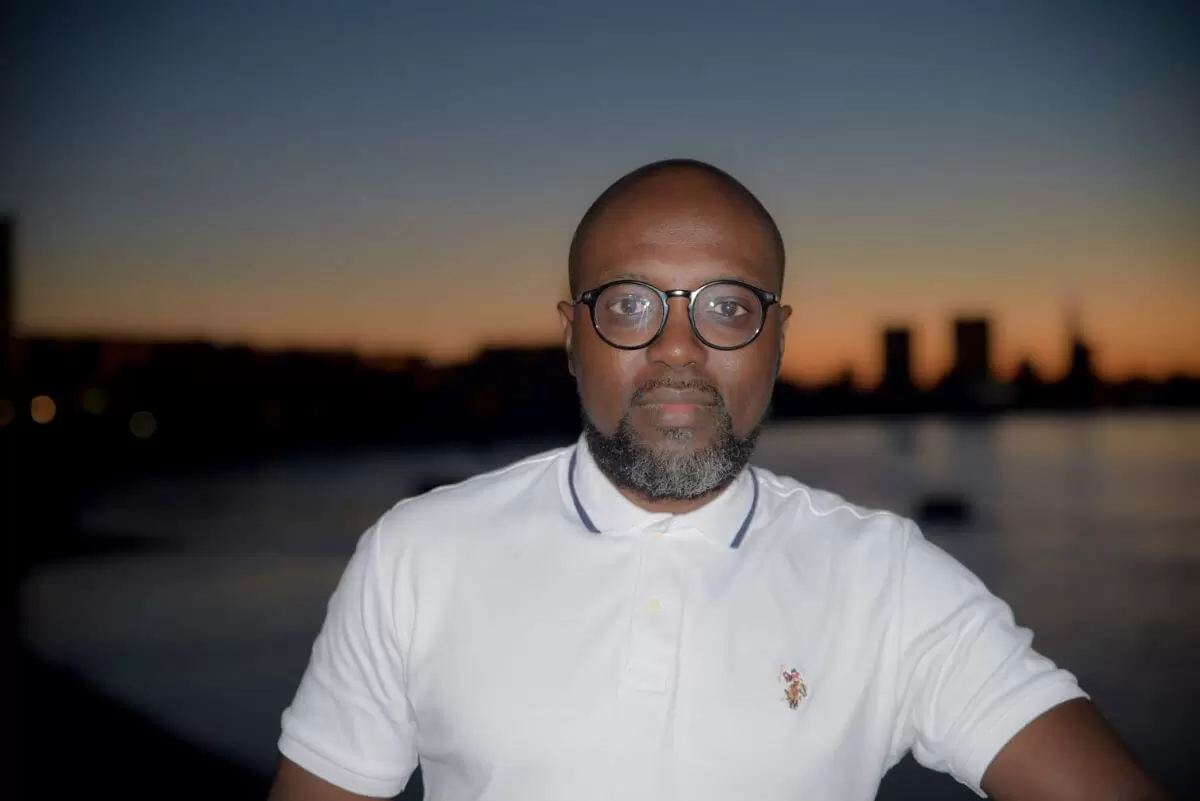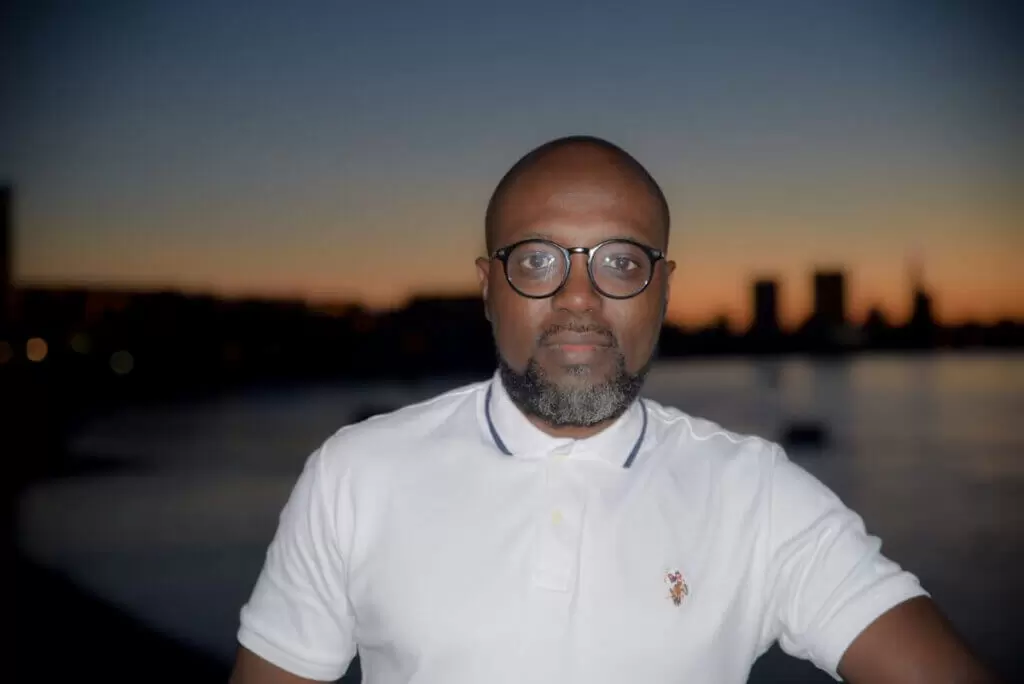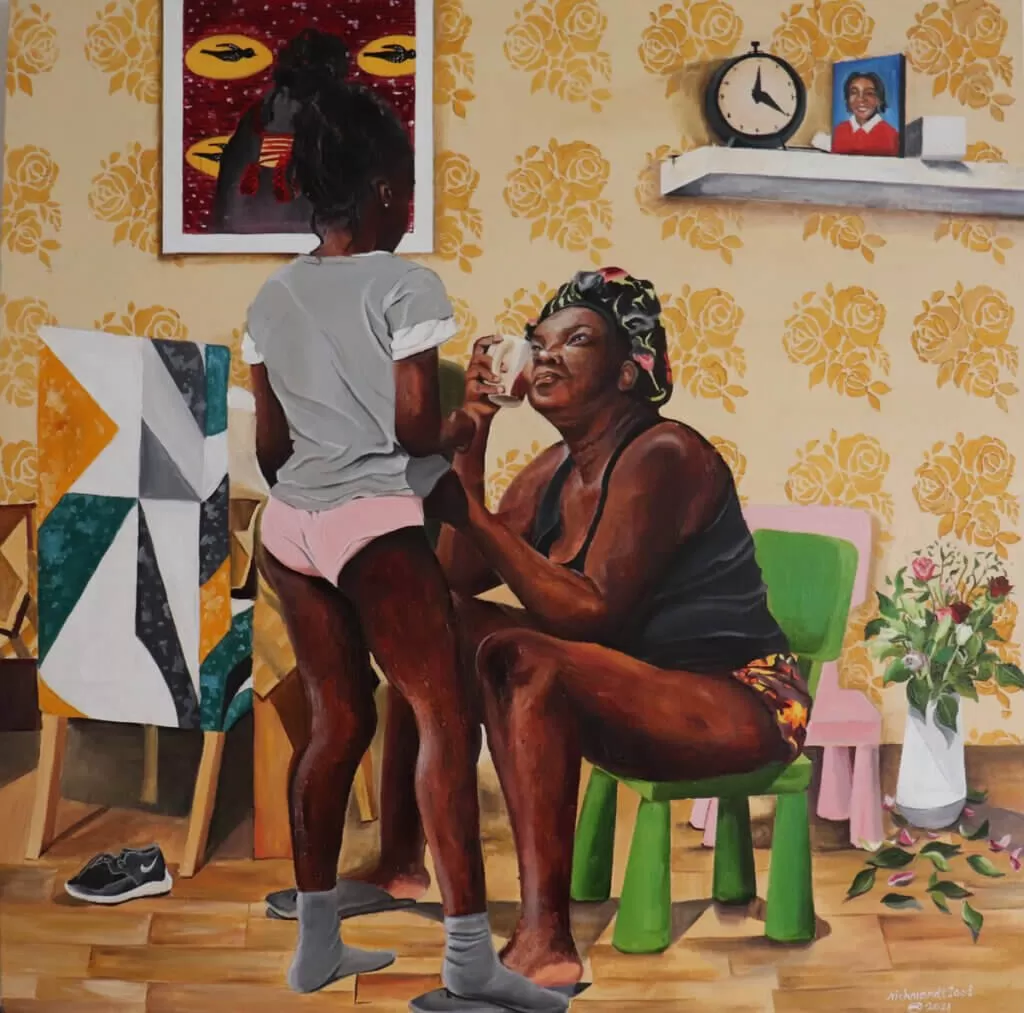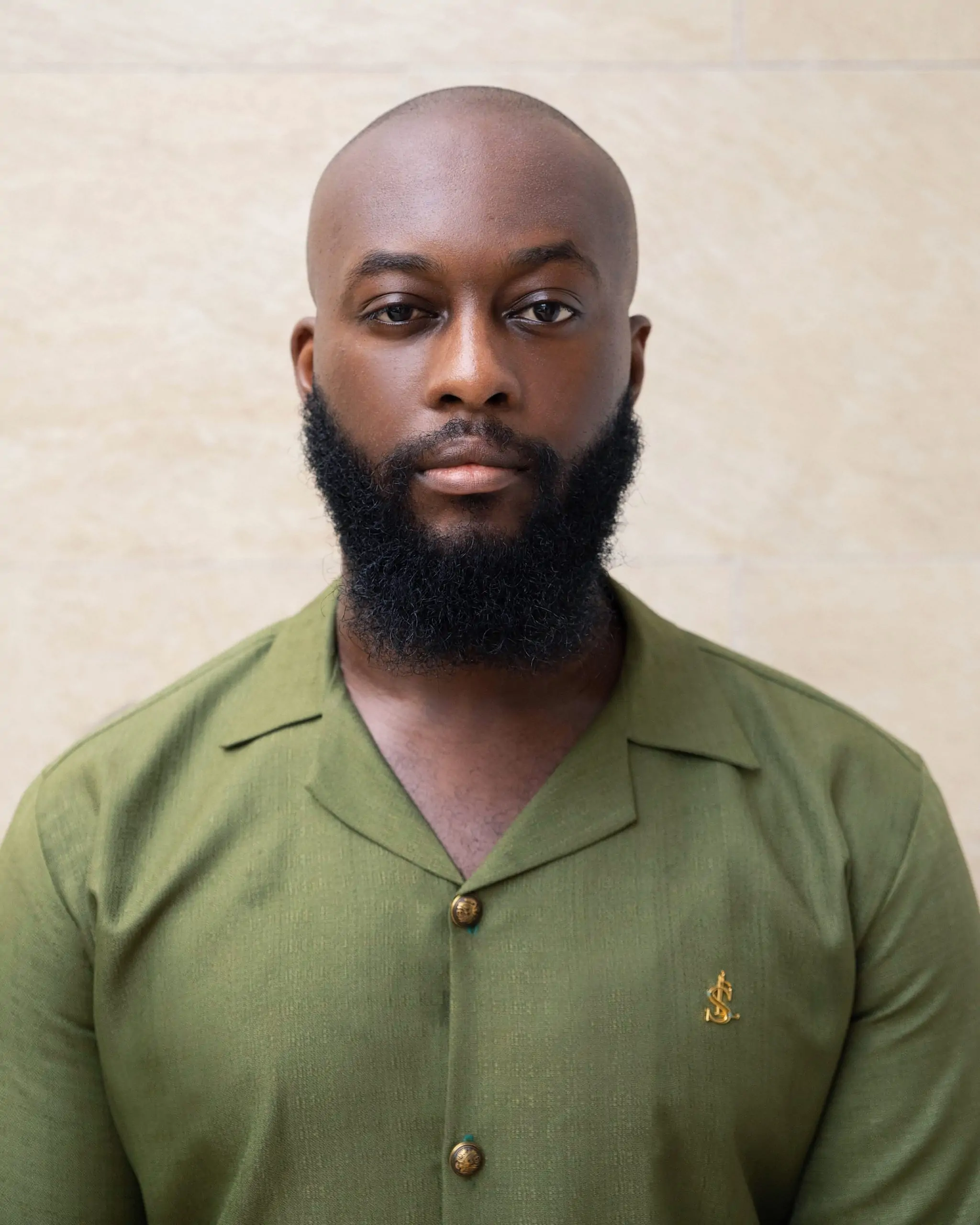Ghanaian contemporary artist, Richard Mensah, is on a noble mission to shape the narrative and perception of people of African heritage globally. Through his mesmerising grand portraits, he showcases an alternative version of global history, depicting the achievements, tenacity and resilience of a proud and victorious people, committed to preserving their culture, beliefs and values in the face of oppression and even death.
My practice is to balance the often missing visual representation of critical African/Black historical events and narratives that should be given prominence but are completely missing or not covered adequately in art spaces.
Richard Mensah
Born and raised in Ghana, and now based in South London, in a few short years, the scientist turned artist, has steadily built a great name for himself, and has piqued the interest of some of the most prolific and important international art collectors and patrons of today.
Raphael: I think by now it goes without saying that I am a huge supporter of your work, and the narratives you address. Bias aside, with you being my countryman and all, you are a superb artist, and more than that, you are an important one for reasons we will touch on later.
Q: When would you say your journey as an artist began in earnest, and how would you describe it so far?
Richard: I have always been an artist and describe myself as a born artist rather than self-taught because I never taught myself. I have always sketched, drawn and painted since I could remember anything. After a very long break from creating art, I got back into art again circa 2017 and gradually dedicated more time to my practice as the years went by.
I started painting more when the COVID-19 pandemic first hit in early 2020 when I got a break from my other commitments.
So far, it has been amazing, hard work and patience, which is always tricky in the world. I have met many wonderful people and see every day as a growth opportunity for me in the art world. The support for my work has been outstanding, and I am always appreciative of my collectors and supporters worldwide.
Raphael: One of the reasons I first fell in love with your work was for sentimental reasons. You captured an iconic historical scene, one of the five major battles of the Anglo-Ashanti war, with such detail and depth that you could almost hear the roars of the rifles firing and smell the smoke, decay and death in the air.
Q: What drove you to capture such an untold historical portrait, and what else in this vein of work can we expect from you?
Richard: My practice is to balance the often missing visual representation of critical African/Black historical events and narratives that should be given prominence but are completely missing or not covered adequately in art spaces.
I have always been fascinated by the rich Ashanti history and culture. I have been drawn to some of the key battles and resistance between the Ashantis and the colonial masters.
In particular, the first Anglo Ashanti painting is to provide some needed balance to the narrative that the African or Blackman did not provide any resistance when they were being enslaved or colonised.
The Ashanti history presents tangible evidence that the often portrayed or accepted narrative is not the case. It showed that our ancestors resisted and fought and won some of these battles against the oppressors and were not weak, as portrayed in many historical accounts.
Raphael: It would be remiss of me not to ask, and I’m sure our readers would be keen to know. In recent times you’ve entered the private collections of art enthusiasts and more serious and prominent collectors. You’ve also piqued the interest of quite a famous collector in Ms Tina Knowles, mother to Beyonce Knowles.
Q: How does it feel to have your work so widely sought after, despite not yet having a major solo exhibition under your belt; what would be the pinnacle for you as far as private or institutional collections you would love to be a part of?
Richard: It feels good to create work and for it to be appreciated. Again, I will say that I appreciate the support from all my collectors and those waiting to collect as well.
It will be nice to have some of my works contribute to the history of African or Black art and enrich people’s lives. I believe in putting in the hard work, creating works that will contribute, educate and add to the culture. If any of my pieces find themselves in any private or other institution collections, I hope it is to achieve one of the objectives I’ve mentioned. This, to me, would be the pinnacle, not the prestige of the collector or the institution.
Raphael: Social media has in recent years played an important role in connecting artists with collectors, curators and gallerists. Even more so in this pandemic, it’s proven to be the saving grace of the global art market at large, with virtual shows going from being a novelty to the norm.
Q: What role has social media played in your journey as an artist, and your ability to connect with both a local and international market?
Richard: Social media has played a vital role for me as an artist. It has connected me to many incredible people – collectors, curators, fellow artists and many more. It has somehow democratised art and made it accessible to a lot more people, which I think is excellent.
You alluded briefly in one of your questions to the fact that I haven’t had any major solo shows, but some of my works have found themselves in front of some incredible people. A lot of this has been through social media. The benefits have been immense, and I believe that it will play a significant role in my practice as an artist.
Raphael: Now we know contemporary African art has been on the rise in the last decade, and even more so in the last few years. I think it is irrefutable that this demand has been in part stimulated by artists of Ghanaian heritage who have especially been leading the charge, notably those who graduated from Ghanatta School of Art & Design, and from Kwame Nkrumah University of Science and Technology (Tech).
Q: How do you feel about the rise of Ghanaian artists, and what in your view is contributing to this rise?
Richard: Even though I went to Kwame Nkrumah University of Science and Technology, I went there not to study art but engineering. I think it is incredible to see so many outstanding Ghanaian artists doing so well and, as you rightly said, leading the charge.
I am always happy to see the underdog doing well, and African/Black art has been the underdog for far too long. It is good that we are beginning to get the proper recognition. I am sure several factors are contributing to this rise, such as effective use of social media by artists, the authenticity of African/Black art, peoples’ consciousness being piqued by recent social events or the art world realising that there is money to be made from investing in Ghanaian or African artists.
Raphael: There are those in the art sector of a conservative ilk who are skeptical about the rise and demand of contemporary African art, likening it to a temporary bull market that will ultimately fall.
Q: Do you believe this demand is sustainable, and likely to continue, or like all highly speculative markets is liable to eventually crash?
Richard: It is a yes and no answer depending on several factors. Yes, in the sense that if African artists maintain their authenticity and continue to create ‘relevant’ good works, then indeed, the demand can be sustained.
The no is if African artists become too predictable and create works that are part of the latest trends or fads, then very soon as with all trends, it moves on, and the demand will ultimately fall.
Raphael: Outside of art, I know that you also lead a demanding professional life as a scientist, and as a family man.
Q: How would you say your day to day profession and personal life has impacted you as an artist, and what would you change, if anything at all?
Richard: I take a lot of inspiration from my family. Many of the ideas conceived for many of my paintings are from day-to-day interactions with my family. My other profession as a Scientist is demanding, and it takes a lot of my time than what I am willing to give if I am honest.
However, I believe that, like art, I contribute to making the world a better place for posterity. There are times I wish I had more time to create, so that is a negative impact on my art practice. If there is one thing I can change now, it will be to get more time to create art. I know this time is fast approaching.
Raphael: I believe like many of us, you come from a generation of African families, who did not consider art a worthwhile pursuit or future career.
Q: Now that you are an artist, and also nurturing your own children’s artistic prowess, notably your daughter, would you say your upbringing has shaped how you encourage your children’s creativity
Richard: Our parents’ generation was different. They did not see art as a worthwhile career, as you’ve rightly mentioned. They, therefore, did everything to push us away from pursuing art, I will add with good intentions. Now that I have been fortunate to do many different things – as an engineer, scientist and artist, I have a good perspective and understanding of what other careers entail.
Therefore, I let my children experiment and go in any direction they want to go. My daughter sees herself as a great artist, and I agree and encourage her to be just that.
Q: What is next for you as an artist, and what can we expect in future, as far as a new series of work, or any group or solo exhibitions?
Richard: As an artist, I want to keep improving, putting in the effort and seeing what the universe has in store for me. My greatest hope is for this generation to be enlightened more through art which I hope to be one of the artists contributing to this.
Once I am done with my current series, I will be exploring the narratives around African/Black families, how we see ourselves and how society perceives us and shedding a little bit of light on our lives.
Again the work will seek to correct some of the imbalanced narratives on African/Black families. On how we are perceived and our role and contribution in society. In terms of solo or group shows, I will say watch this space for some announcements.
Raphael: As you know from our in depth discussions offline, one of my greatest motivations as a historian, writer and a curator, but above all as an African, is to tell our stories. Before we go, tell us, what is your goal and purpose as an artist.
Q: What are you hoping to accomplish and achieve in this industry?
Richard: There is one thing about me: if I cannot give my best, there is no point in starting. This should not be equated to seeking perfection, but I hope that my efforts and thoughts that go into my art will positively contribute to people’s lives.
These are the there main things I hope my works achieve in this industry:
● To educate, to educate my audience through art, especially those in my community, to know and understand our history and culture.
● Representation; to provide a balanced representation of the African/Blackman’s story to the world.
● To empower; to empower those from my community through the use of visual art. My work tries to capture the strength, beauty and the power of African and Black people.
https://www.instagram.com/officialrichardmensah/
https://www.richmends2001arts.com/
©2021 Richard Mensah









